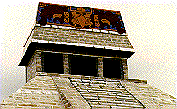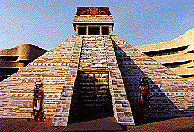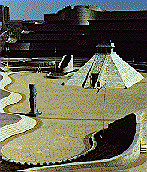 The Maya are probably the best-known of the classical civilizations of Mesoamerica. Originating in the Yucatán around 2600 B.C., they rose to prominence around A.D. 250 in present-day southern Mexico, Guatemala, northern Belize and western Honduras. Building on the inherited inventions and ideas of earlier civilizations such as the Olmec, the Maya developed astronomy, calendrical systems and hieroglyphic writing. The Maya were noted as well for elaborate and highly decorated ceremonial architecture, including temple-pyramids, palaces and observatories, all built
without metal tools. They were also skilled farmers, clearing large sections of tropical rain forest and, where groundwater was scarce, building sizeable underground reservoirs for the storage of rainwater. The Maya were equally skilled as weavers and potters, and cleared routes through jungles and swamps to foster extensive trade networks with distant peoples.
The Maya are probably the best-known of the classical civilizations of Mesoamerica. Originating in the Yucatán around 2600 B.C., they rose to prominence around A.D. 250 in present-day southern Mexico, Guatemala, northern Belize and western Honduras. Building on the inherited inventions and ideas of earlier civilizations such as the Olmec, the Maya developed astronomy, calendrical systems and hieroglyphic writing. The Maya were noted as well for elaborate and highly decorated ceremonial architecture, including temple-pyramids, palaces and observatories, all built
without metal tools. They were also skilled farmers, clearing large sections of tropical rain forest and, where groundwater was scarce, building sizeable underground reservoirs for the storage of rainwater. The Maya were equally skilled as weavers and potters, and cleared routes through jungles and swamps to foster extensive trade networks with distant peoples.
 Around 300 B.C., the Maya adopted a hierarchical system of government with rule by nobles and kings. This civilization developed into highly structured kingdoms during the Classic period, A.D. 200-900. Their society consisted of many independent states, each with a rural farming community and large urban sites built around ceremonial centers. It started to decline around A.D. 900 when - for reasons which
Around 300 B.C., the Maya adopted a hierarchical system of government with rule by nobles and kings. This civilization developed into highly structured kingdoms during the Classic period, A.D. 200-900. Their society consisted of many independent states, each with a rural farming community and large urban sites built around ceremonial centers. It started to decline around A.D. 900 when - for reasons which
 are still largely a mystery - the southern Maya abandoned their cities. When the northern Maya were integrated into the Toltec society by A.D. 1200, the Maya dynasty finally came to a close, although some peripheral centers continued to thrive until the Spanish Conquest in the early sixteenth century.
are still largely a mystery - the southern Maya abandoned their cities. When the northern Maya were integrated into the Toltec society by A.D. 1200, the Maya dynasty finally came to a close, although some peripheral centers continued to thrive until the Spanish Conquest in the early sixteenth century.
 Maya history can be characterized as cycles of rise and fall: city-states rose in prominence and fell into decline, only to be replaced by others. It could also be described as one of continuity and change, guided by a religion that remains the foundation of their culture. For those who follow the ancient Maya traditions, the belief in the influence of the cosmos on human lives and the necessity of paying homage to the gods through rituals continues to find expression in a modern hybrid Christian-Maya faith.
Maya history can be characterized as cycles of rise and fall: city-states rose in prominence and fell into decline, only to be replaced by others. It could also be described as one of continuity and change, guided by a religion that remains the foundation of their culture. For those who follow the ancient Maya traditions, the belief in the influence of the cosmos on human lives and the necessity of paying homage to the gods through rituals continues to find expression in a modern hybrid Christian-Maya faith.
 Maya civilization
Maya civilization Maya civilization
Maya civilization